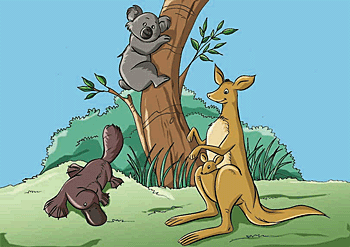zoo-, zoa-, zo-, -zoic, -zoid, -zoite, -zoal, -zonal, -zooid, -zoon, -zoa, -zoan
(Greek: animal, animals; living beings; life)
1. Any of various protozoans with whip-like appendages of the subclass Zoomastigina, lacking plantlike characteristics:
Zooflagellates are protozoa possessing moveable threadlike or lash-like structures, or "flagellum", and specifically those protozoa having "flagella" (plural of "flagellum") or long, whip-like "tails" of certain cells in both the plant and animal kingdoms, which undulates with a regular pattern. They are used primarily for locomotion and also for other purposes, such as attracting food particles or moving substances through a "mouth" cavity.
2. Etymology: from Latin meaning "whip".
2. Etymology: from Latin meaning "whip".
A yellow pigment in bird feathers: Zoofulvin, or xanthophyll, can be found in the plumage of touracos, which are brightly coloured African birds with very prominent crests, and the American Goldfinch, which is quite widespread.
A motile ciliated mature sexual reproductive cell; planogamete: A zoogamete can move independently and is found in isogamous plants and green algae.
zoogamous (adjective) (not comparable)
Pertaining to animals that reproduce sexually: In her biology class, Samantha learned about the zoogamous aspects of animals of opposite sexes pairing with each other in order to propagate their kind.
The sexual process of producing offspring: Zoogamy includes the pairing and copulating of animals of different sexes for the purpose of reproduction.
The theory of animal production or generation: Zoogenesis is a hypothesis that the significant kinds of life forms developed individually and independent from each other.
zoogenetic (adjective) (not comparable)
A reference to the belief of animal propagation; pertaining to "zoogenesis": For her essay at the end of the semester, Jane finally found some information regarding zoogenetic processes involved with the fauna in the area near her home.
zoogenic (adjective) (not comparable)
Produced by or associated with the activity of animals; zoogenous: In the garden center, Joe wanted to have zoogenic humus to improve his garden soil.
zoogenous (adjective) (not comparable)
1. Produced, acquired, or caused by animals; zoogenic: Little Lynn knew that milk could be bought at a grocery store, but was surprised to know that it actually was a zoogenous product from cows!
2. Originating in or produced by animals; viviparous: Susan found out in her biology book that zoogenous animals were those that gave birth to living young, but not to be confused with oviparous, or egg-laying, animals.
2. Originating in or produced by animals; viviparous: Susan found out in her biology book that zoogenous animals were those that gave birth to living young, but not to be confused with oviparous, or egg-laying, animals.
The development and evolution of animals: Zoogeny can be describe as being the principle or concept of the crystallization of life forms including their organs and parts.
A person who studies and records the geographical distribution of animals and animal communities: Mr. Thompson was fascinated by the causes and effects of the spreading or scattering of animals all over the world, so he decided to continue studying to become a zoogeogropher.

A zoogeographer is entering descriptions in his book about zoogeography.

zoogeographic (adjective) (not comparable)
Describing the relationship between geography and animal life, especially the effect of geographical barriers: Zoogeographic environments, such as deserts, mountain ranges, or oceans, and the type of animal life in that area, determine the development in that region of a country.
1. Any of the major geographical areas into which the planet Earth is divided on the basis of distinct forms of animal life or fauna: One zoogeographical region or "zoogeographical realm" is the Australian region, which includes marsupial and monotreme forms, such as the platypus and the echidnas (spiny anteaters) that are not found elsewhere.
2. Nine such regions exist:
2. Nine such regions exist:
- Palaearctic (Northern Europe and Asia)
- Nearctic (North America, Greenland, etc.)
- Ethiopian (Africa and Arabia)
- Madagascan (east coast of Africa)
- Neotropical (Mexico, Central and South America)
- Oriental (India, Burma, and S.E. Asia west of Wallace's Line)
- Australasian (Australia, New Guinea, and islands S.E. Of Wallace's Line)
- New Zealand (including neighboring islands)
- Polynesian (numerous pacific islands of volcanic origin having no apparent connection with the continents)
The study of the geographical distribution of animals and animal communities: Zoogeography is the scientific investigation of where different faunae live and the causes and effects of such spreading, especially the dispersion on a large or global scale.


A colony of microbes embedded in a gelatinous matrix (a substance in which something is enclosed): Zooglea is a jellylike cluster of bacteria swollen by the absorption of fluids from the medium in which they are grown.
A gelatinous mass of bacterial cells produced by certain genuses, such as "Zoogloea ramigera" which is used to treat sewage.
The bacteria gradually swell up into zoogloea masses, until finally their bodies break down into soluble nitrogenous substances which are partly absorbed and assimilated and partly stored as reserve nitrogenous food by the green leguminous plant.


